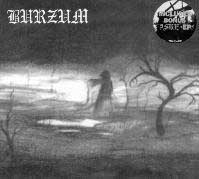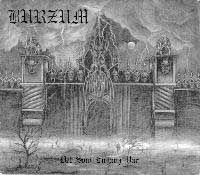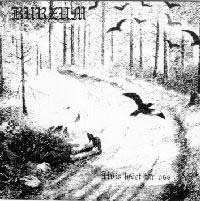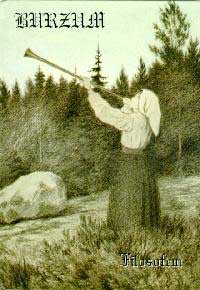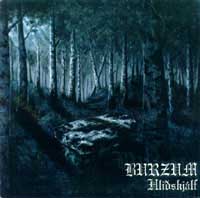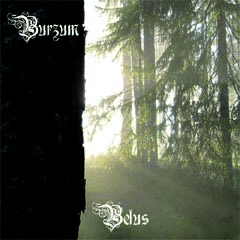Burzum
Burzum - Det Som Engang Var (1993)
Burzum - Hvis Lyset Tar Oss (1994)
Burzum - Filosofem (1996)
Burzum - Daudi Baldrs (1997)
Burzum - Hlidskjalf (1999)
Burzum - Belus (2010)
Production: Reasonable, warm garage organic production.
Review: The first Burzum album helped black metal outgrow popular music by adding complex narrative song structures, advanced phrasal riffs that developed melody over multiple iterations, and a mood that wrought from despair a desire to destroy all false beauty and in its stead, dream what of might be preferred. It creates this outlook through simple, often suffocatingly feral music that communicates the dissatisfaction, misery and anger of a generation trapped in a world where what is claimed to be "good" may be bad, and vice-versa.
As a result, Burzum functions through inversions. Throughout the album, riffs that are borderline simplistic unfold into motifs that grow through time to reduce complexity to the bare minimum, like a traveler paring down luggage and his mental state for an arduous journey. The two centerpieces of the album, "My Journey to the Stars" and "Feeble Screams from Forests Unknown," emphasize a type of deconstruction to literal reality that then flowers into complex, cosmic visions as channeled into through-composed lengthy compositions with a melodic base accentuated by the power chord phrases that comprise its riffs.
Songs repeat simple patterns as part of an enveloping phrase that uses repetitions of its components to project an ambience of the whole, resembling the way William Burroughs wrote Naked Lunch: cutting up a vision into fragments spreading throughout a random landscape, depending on the consciousness of the reader to re-assemble them. Riffs of elemental power chord patterns inject additional notes strummed between chordings to build simple harmonies for biting contrast, as chord voicings vary to embed multiple melodies in harmony.
1. Feeble Screams from Forests Unknown (7:28)
2. Ea, Lord of the Depths (4:51) 
3. Black Spell of Destruction (5:39) 
4. Channeling the Power of Souls into A New God (3:24)
5. War (2:27)
6. The Crying Orc (0:57)
7. My Journey to the Stars (8:10)
8. Dungeons of Darkness (4:50)
9. Stemmen Frå Taarnet (6:09)
10. Dominus Sathanas (3:03)
11. A Lost Forgotten Sad Spirit (10:50)
Length: 57:48
Vocals are lengthy screams that spread the hoarse demonscreech over several notes, often accentuating the rhythms of the riffs (dominant rhythm of each song, lulling hypnotic strum of seething distortion). Like most black metal, this is contrast-counterpoint material that illustrates isolation and despair in the isolated, weeping, enraged howls and the riffs that form a landscape beneath it, as if crafting an opera from industrial noise and vast emptiness. From distortion, machine noises, hatred and morbidity comes a sense of what does have potential bleeding through the wasteland of the abraded.
Yet this violent, obscure ambient metal projects into our consciousness a stimulation of fantasy and from that, a sense of what we would prefer, creating in turn an ugly desire to destroy the ugly and find within beauty. This is the mocking spirit of nihilism that lets us reject calcified social convention and reach for the transcendent, even if it means committing ourselves to warfare so that we might discover real beauty instead of the false self-declared beauty imposed on us by a moribund civilization.
Production: Relatively clear with reasonable amounts of bass.
Review: With this album, the intent to make "ambient metal" pushed Burzum to replace longer narrative songs with shorter looping ones and ambient soundscapes, meaning that instead of working from a principle of telling a story through the change in riffs, the music creates a mood and then selectively alters it internally to make its final motif emerge from within. The result is both the most easily grasped Burzum album and one that falls short on much of the promise of this band.
Reminiscent of early R.E.M., songs create a sparse harmonic structure and then regulate its emotional balance with layers of vocal and guitar variations on a circular pattern of simple themes. Ambience derived from tension through repetition sustains an atmosphere of emotional darkness with internal complexity that turns the monolithic repetition of angst into a flowing narrative of imagination and desire beyond the present. Riffs extend and lull in hypnotic rhythm, like sunlight caught in dancing dust at the end of the day: a melody of chords washing over the last notes, plucking the combinatoric possibilities of the harmonic content of the chords relative to the dominant motif of the song, in beautiful contrast of haranguing noise and its lingering beauty of decomposition.
A deliberate concept album which presents in macrocosm a topography of moods much as the longer songs of the first album did, Det Som Engang Var is a hybrid between ambient metal and the narrative structures that made black and death metal rise above the popular music morass. Much as Blessed Are the Sick by Morbid Angel provided a codex to unlock the methods of constructing death metal, the second Burzum album explains black metal and the clash between the ancient (narrative) and modern (ambient) by resolving them both to a primitive outlook on life, a spiritual holocaust that eliminates our feelings and judgments and replaces them with the hard reality of a cold night in the forest.
Production: About appropriately both clear and roomily distant.
Review: On this album Burzum evolves to a simplicity of rhythmic communication under a dark mood suspended in the ambient tones of distorted guitar, but re-introduces thematic narration to make the album that raised the bar for black metal so much that it forced other bands back toward less ambitious works. Recombinations of scale fragments balance a nihilism of tonal equality with a chaotic will to melody, building each song from progressions of simple riffs that emphasize a pulse in their dominant strokes.
In this, Hvis Lyset Tar Oss comes closest to achieving the ideal of the ancient Greeks: an epic poem set to music and choreographed to the motions of actors on a stage, telling a story that is both literal and of mythic symbolism, which Burzum expresses through motif slices that resemble the leitmotifs of Richard Wagner. The listener becomes enmeshed into these tracks and subsequently shocked awake when their evocative structures unfold and implode, blooming a wistful moment of both realization and emotion, resignation and resistance.
Of four tracks, three are lengthy (11, 8 and 15 minute) minimalist epics of driving technoesque beats and strobing guitar that leaves a passage of time resonating with the entirety of the greater phrase which in its own subtle way shares the fundamentals of each component phrase. Emergent ideas project and converge merging with a distant reality as these songs articulate their pain; then into the cold of silence drops a sparse ambient keyboard piece of ten minutes called "Tomhet," absolute minimalism that portrays dark reflections of a dying age. Thus concludes a brief vision of eternal order rising from necessary violence and then chaos, presenting the human soul yearning for more than the functional before vanishing into despair with the enigmatic afterglow of a falling star.
Production: Clear but thinner and less murky, this album was patched together while the artist was in prison, with vocals recorded through headphones and layers of guitar played through an old stereo, giving it a metallic and reedy sound.
Review: Both evolving to simplicity and devolving to pop music, Burzum produces a troublingly obscure and romantic work. Ambient song structures, where a circular pattern gains variant details in each iteration, incorporate the narrative structures of earlier Burzum within these loops, but most notably in the epic atmospheric keyboard opus that, framed by mirror-image purely ambient guitar noise pieces, concludes the album.
The first three songs define the "Odinpop" format that makes this album a fan favorite: verse/chorus, with a long bridging deviation that weaves harmonic detail through a simple progression, creating an enveloping sound like a microcosmic version of Anton Bruckner's "sonic cathedral" approach in which aspects of harmony were added or subtracted to create a prismatic structure, or one in which repetition because non-repetitive because of the changed context into which repeated phrases were injected.
The simple percussive matrices that are its rhythms emphasize underlying simple phrase beats played in the cutting distortion of the guitar, the combination of percussion and duration revealing the components of each note and chord simultaneously. With a flexible strumming technique that smears a distorted flow of notes into chords and melodies, hypnotizing with sound in the simplest components of a song that builds a mood from the ambiguity of the melodic recombinance of the musical space that emerges. Strobing, pulsing, living music radiates from these simple, definitive riffs and the undulating strum that with speckled harmonics creates a sense of the indeterminate beneath.
Emotion comes from the rasping voice distorted to merge with the electronic organic mass of sound, rhythmically adept to insert the contortions of speech in anguished, hopeless ferocity. Like most pop, it is self-indulgent to the edge of being egodramatic, but in this case a contemplative mood takes over in a clarity of purpose distilled to simplicity. Not as cutting, destructive, and angry as earlier releases it seems more reflective and nihilistic, recognizing prison as an indifferent destiny in a world this repulsively stupid.
Production: Direct transfer from digital sequencing keyboard allows sound to exist in abstract space of algorithmic tones and perfect silence.
Review: An extension of the minimalistic atonal symphonies which layered basic tone progressions over each other in fugues of masterful narrative layout, approaching a more complex ideal of song structure and its influence on the elements of the song, Balder's Dod constrains the pop-like melodic tendencies of the previous Burzum album to classically-inspired ambient looping structures, with less emphasis on overlay and harmonization as on sheer mutation of riff, song, and structure alike.
1. Daudi Baldrs (8:49)
2. Hermodr a Helferd (2:41)
3. Balferd Baldrs (6:05)
4. I Heimr Heljar (2:02)
5. Illa Tidandi (10:29)
6. Moti Ragnarokum (9:05)
Length: 39:11
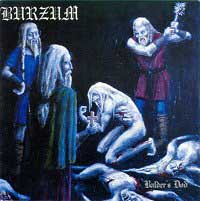
Copyright © 1997 Misanthropy
Often reusing familiar themes from Filosofem, this music manipulates a traveling show of ancient delights in a narrative winding its way through dark emotions best described as harmonizations to a fantasy conceived in a dream. Obscurity reigns in the simple anti-riff patterns that fulfill the demand of a single-note lead for a constantly engaging melodic tension with tone sequences modifying themselves in subtle but structurally significant ways, throwing doubt on the structure and giving it the romantic requisite of dual nature and emotional wanderlust. Where in Plato's cave one saw silhouettes, in Grishnack's castle the light is hidden under shadow.
The repetitive nature of Balder's Dod and the frequent lack of percussion instruments makes it a difficult chew for modern listeners, especially those expecting metal music where rhythm and melody are given separate musical voices. However, with their Dead Can Dance-inspired medieval format, these works continue the explorations of early Burzum in ways perhaps more profound than Filosofem, which stagnated into wistful, almost drunkenly poignant pop music; here there is a new austerity of persona in the malevolent and brooding soul of nature restless in the presence of sleeping humanity.
Production: This release being digital, there's not much to say here.
Review: Continuing its arc of growth, Burzum accelerates its development to a form of mellow but austerely ancient "ambient soundscape" music that must be understood at an abstract level to appreciate its real beauty. As with the previous album, the Dead Can Dance influence is present, possibly merged with Tangerine Dream (as the Darkthrone sideproject Neptune Towers did) and Kraftwerk, an admitted influence of its creator.
Burzum has evolved from raw black metal to an atmospheric style of classical music that reflects powerful concept and design. While contemporary audiences have come to expect simpering emotion from ambient music of such a non-industrial/noise nature, this foray into making a modern interpretation of early music and all the cultural weight it carried nonetheless manages to create a deepending atmosphere and a sense of gravitas that is missing from most music except metal. It does not sound metal, but it has the spirit that metal and early music share in common: a clear-eyed look at reality and embrace of its violence, chaos, tragedy and also, beauty and triump.
Underneath the lush skin of melodic layers comprising this music is once again the product of a highly refined musical thinker crafting distinctive works that speak the uniqueness and complexity of a situation or mood. Keyboards sequenced together with minimal percussion play in "lead" rhythm roles, where instead of extensive soloing comes in-depth interaction between multiple instrument voices. Ambient long tempo structures and hypnotic pulsations of rhythm put this album in a dominant background role to your attention span, as if it were a soundtrack or sequence of demonic commands.
Despite stratigraphic construction, this music is ultra-minimalistic: like Bach, many small pieces, recombinant versions of each other, interact to form a complex style and overall architecture. Classical in thematic architecture and concept, Hlidskjalf wears the surface of ambient soundscape while its muscles are raw, intense, nihilistic concepts in music.
Production: Crisp studio take on Filosofem approach.
Review: Complex enough by its method to exceed linear thinking, the latest from Burzum appropriates its aesthetic from the droning black metal of the past generation, but as it lacks the original organizing principle that propelled this one-mand band to great works, it ends up being highly competent aesthetic embellishment on deconstructions of the original Burzum idea. Where it once created, it now destroys.
Starting with a re-iteration of the theme from "Baldur's Dod" after a brief introduction that sounds like a satire of Einsturezende Neubauten, the album launches into three songs that resemble a Ukrainian or Russian droning black metal band imitating Burzum. In doing so, they reveal how much the droning black metal style borrows from the Swedish melodic death metal of the previous generation, because when the music increases a level of complexity as Burzum does, it sounds more like Unanimated or At the Gates with black metal rhythms. Where previous albums were through-composed with longer melodic phrases, this album comprises plays on harmony, embellished with trills, fills and decorations.
With the exception of "Kaimadalthas Nedstigning" and "Sverddans" which sound like recycled material from the pre-Burzum era, the latter half of the album drones in minute variations on monotonous themes, producing a sense of profoundly directionless pandering -- like modern society and exoteric Christianity. Nothing here is badly composed but two cliches must be addressed: the sum of the parts does not form a greater whole, and the album has become an end in itself instead of a means to an end, which is the expression of some immortal idea relevant to life. As a result, this has the aesthetic power of wallpaper on which all of the demons are drawn as flowers.
Biography
Formed in 1991, Burzum rose from the ashes of Uruk-Hai through the hand of its sole creator, Kristian "Varg" Vikernes, who played all instruments and wrote all the music. In addition, he joined Mayhem as a bassist and shared lyrics and possibly music with Darkthrone. Once he found a sound he could work with, he wrote his first five albums in the span of two years and then became notorious for killing Euronymous of Mayhem and burning at least one church, the Fantoft Stavechurch which was a Norwegian national monument.
While in prison, he released two keyboard-based ambient albums and numerous statements alluding to Odinist, National Socialist and anti-Judeo-Christian political beliefs. For this reason, he remains one of black metal's most charismatic and yet threatening figures, in that he completely rejects modern society and its underpinnings of equality and tolerance, and also, seems ready to act on those beliefs with aggression.
 In a search for what black metal would become it became necessary to find out what it meant, and that leads us to a category of black metal bands who are "the conceptualizers," most notably, Burzum, Darkthrone and Immortal. However, it is only Burzum who exceeded the epic with the majestic in terrifyingly abstract and emotional music.
In a search for what black metal would become it became necessary to find out what it meant, and that leads us to a category of black metal bands who are "the conceptualizers," most notably, Burzum, Darkthrone and Immortal. However, it is only Burzum who exceeded the epic with the majestic in terrifyingly abstract and emotional music.
Created to "stimulate the fantasy of mortals," the music of Burzum is vengeance of chaos against the propagation of administrative and technological models for human existence, ideas which demand allegiance to rules and "morality," or the wisdom of mercy and social compromise as seen by Judeo-Christian technocratic society. Thrusting his fist in the face of that evident death-worship, Grishnack enfolds the rejected darkness in the lucidity of structure in the most forebodingly empty and threatening views of the world.
Total nihilism reduces its belief in inherent nothing to nothingness and from that builds to absolutist ideologies which avoid the emptines discovered; Burzum carries this passion in music and lyrics as well as artistic conception and presentation. The includes the darkly organic Pagan neo-Nazi post-Nietzschean philosophies which Varg spouts in fragments to a barely credible and barely listening press. He envisions his ideology and music as a continuation of Nazi Germany in the 1940s as a pagan revolution against Jewish and Christian (Judeo-Christian, including Islam) influence, notably "morality," against which not only Nietzsche but other influential thinkers have railed (Burroughs, Schopenhauer, Wittgenstein, Pound, Shaw).
 While unorthodox to the tastes of the public, these political beliefs must be understood for the complex ideological system they express at the approach of the demise of a materialist civilization. In postmodernist thought, we learned that our society operates with a justified "text" of ostensible motivation, and a submlimated "subtext" of desires and natural passions. As society continues to crumble toward moralism in the midst of self-destruction, newer thinkers look away from Judeo-Christianity and Liberalism toward older modes of thought which valued the place of all of humanity in nature before the "moral worth" of the individual.
While unorthodox to the tastes of the public, these political beliefs must be understood for the complex ideological system they express at the approach of the demise of a materialist civilization. In postmodernist thought, we learned that our society operates with a justified "text" of ostensible motivation, and a submlimated "subtext" of desires and natural passions. As society continues to crumble toward moralism in the midst of self-destruction, newer thinkers look away from Judeo-Christianity and Liberalism toward older modes of thought which valued the place of all of humanity in nature before the "moral worth" of the individual.
For more information on the Judeo-Christian basis to materialist civilization in the twentieth century, read Friedrich Nietzsche's "Genealogy of Morals," sections 7-10 (describes the virus of Judaism and Christianity as a cult of psychological dependency and need, resulting in sublimated sado-masochistic power-obedience behavior) or Vaclav Havel's "Power of the Powerless." Also, to understand Vikernes, it is useful to study Northern European culture in its origins from Asia to India, and its history as an independent and noble community that used naturalistic values for the basis of its social structure, in dramatic opposition to the materialist culture to come with the rise of Jewish and Christian immigrants to Europe.
Long before the first Christian appeared in a misty fjord, the Norwegian people had a socialist approach to family, an open and fearless society, a hierarchy of metaphorically symbolic gods, and a world-exploring culture. Their trading partners were mutually considered equals, and their women had more freedom than in any other society on earth. Their values reflected the least of Nietzschean "clever" or "lower" materialist values and the highest of materialist-transcendent "noble" or "warrior" values. During the occupation, Northern Europeans have modified capitalism/socialism and Christianity to their most benevolent forms ever while maintaining one of the nicest places to live in the world with the least hypocritical and vengeful moralistic influence of the civilized nations. European society has suffered its 1,000 years of Christianity and as pro-Judeo-Christian influences in politics and media build in America and the island England, desire for separatism and neutrality is on the rise.
As a result, Burzum stays controversial: not answered, not rebutted, not forgotten and not even carried on. This work is simply enduring as both music and ideological impact of emotion and action.
